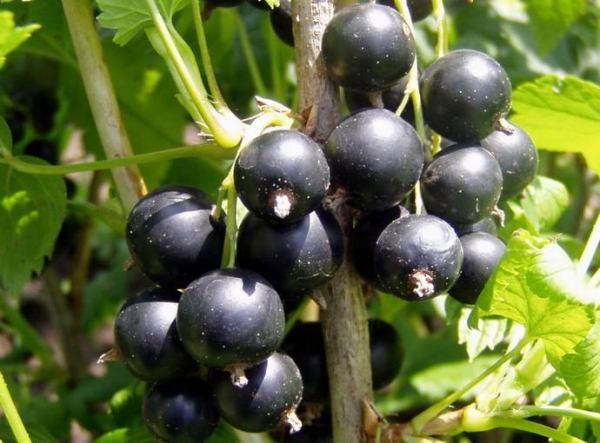It is difficult to find a garden plot without bushes of black currant. Her plant everything and everywhere - garden, garden, cottage. The most difficult thing to decide on the choice of varieties, there are now more than 200 species.
Currant berry is tasty and healthy. In order for it to be longer on our table fresh, it is desirable to have varieties of different ripening terms at the site.
In terms of ripening currant is divided into early, middle, and late. Will consider currant variety of early ripening - Selechenskaya.
Table of contents
Description and characteristics of the variety
The variety was obtained by A.I. Astakhov in the 90s of the last century as a result of the crossing of varieties of Seedling Dove and Bredthorp (line 32-77).
Berries are large, weighing 2.2-5.0 g, round, black, the thickness of the peel is medium, the berries are dry. The ripening of berries is the first decade of July. Berry is sweet, tastes 4.6 points on a 5-point scale.
The purpose of the berries is universal, according to the characteristics they are good both fresh, and in freezing and processing.
Good winter hardinessresistant to spring frosts, tolerates drought.
The advantages of the variety are high yields. (up to 2.5 kg / bush), large-fruited berries, high taste (sweet and sweet, dessert), harmonious ripening of berries.Resistance to powdery mildew and kidney mite is good.
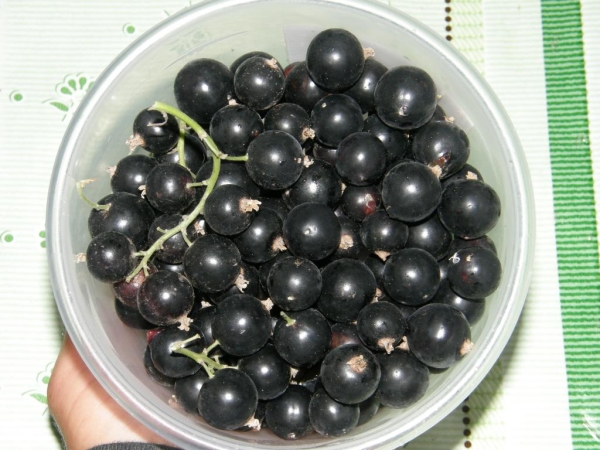
Currant variety Selechenskaya refers to varieties of intensive type and therefore demanding of soil fertility, fertilizing and watering in dry years.
Compared with its predecessor he is more productive (3.5 kg / bush), the size of the berries reaches 5 grams, the berries are more sweet with a pronounced currant flavor. The skin of the berries is thin. Tasting assessment of berries 4.9 points. Ripens in late June.
The variety is less demanding on agricultural cultivation (frost and drought resistance are high), resistant to powdery mildew and anthracnose.
The bush is compact, erect, the branches under a bountiful harvest do not bend and do not need a garter. This is the best sort of breeder A. I. Astakhov.
Description and characteristics of a grade of currant Selechenskaya-2:
Planting seedlings Selechenskoy currants
Black currant Selechenskaya, like any black currant, moisture-loving plant with shallow root system. This should be considered when choosing a landing site.
The place should be well lit, but not sunny. (in the midday hours it is desirable for her to be in the penumbra), sufficiently moist and protected from the winds.
Planting pits are filled with organic fertilizers and ashes, if desired, mineral ones are added, for example, superphosphate. The soil in the places of placement of currants should not be acidic, for deoxidation in the soil in the fall, lime is added for digging at the rate of 0.5 kg / m2.
It is possible to plant currants both in the spring, and in the fall, but autumn planting is preferable.

Black currants are planted at a distance of 1-1.5 m between bushes in planting pits measuring 40 × 40 cm.
Planting bush produce at an angle of 45 degreesthat will contribute to the formation of additional roots and new shoots from the recessed buds.
Sapling when planting deepen to 10 cm and pruned branches, leaving 3 buds above the soil surface. This will contribute to better rooting and development of the seedling.
After planting, we water the planted currant bushes, compact and mulch the earth. For the winter, the young sapling is sheltered with fallen leaves for a better wintering.
Spring planting is limited in time. Black currant wakes up early, and you need to plant a sapling before budding begins. If you are late with planting the plant will take root badly and hurt.
Black Currant Care
If you planted on the site such currants as Selechenskaya and Selechenskaya-2, this is not a reason to forget about plants for a long time. Without proper care, you should not place high demands on them. Plants need regular watering, dressing, shallow loosening of the soil.
Currant Selechenskaya moisturelovetherefore needs watering. For this, it is advisable to make grooves up to 20 cm deep at a distance of 40 cm from the end of the branches and watering in them, consuming at least 30 liters of water per m2. Fertilizers can be applied to these grooves.
After watering the soil around the bushes need to mulchor cover with black agrofiber. It will protect the plant not only from the evaporation of moisture and the formation of a crust, but it will not give the opportunity to grow weeds, it will eliminate the necessary regular loosening of the soil under the bushes.

Currant needs top dressing as well as irrigation.. In the spring, urea is applied to the bushes - 30 g per m2, after flowering, liquid organic fertilizers are applied with 20 g of urea added to the bucket of organics, and after harvesting again organic fertilizers.
Once a fortnight, foliar top dressing is done on foliage., combining them with treatment against diseases and pests. In order to deoxidize the soil in autumn, it is necessary to add ash under the currant bushes, with subsequent incorporation into the soil.
Pruning bushes
Pruning currant bushes needed for the formation of bushes and maintain their productivity.
Black currant fruits mainly on the growth of the last year, so old branches need to be deleted for constant renewal of plants.For better illumination of bushes also need to be thinned regularly.
The next year after landing 3-4 well-developed and located from the grown up root shoots are left, and if the ends of the shoots have not matured, they are also removed. In subsequent years, trimming is the same.
Removed weak and thickening shoots of the bush, sick and dry. Of the zero shoots (shoots grown from the soil) annually leave no more than 4 of the strongest. So that the bush does not thicken, the distance between the young shoots should be 10-15 cm.
For the rejuvenation of the bush old branches are cut, it gives impetus to the growth of new ones.
Important when pruning:
- Pruning of black currant bushes should be done in the spring before bud breaks, in the fall before the onset of frost;
- branches older than 5 years old are removed;
- when pruning hemp can not be left, they settle pests and diseases;
- in order to avoid diseases, the bush should not be thickened, therefore thinning of the bush is necessary;
- shoots of zero order are left the strongest and well developed.
Breeding
Propagated black currant layering and cuttings.
The simplest and most commonly used is method of reproduction by horizontal layers. For this, in early spring, shallow grooves are being dug up by the bushes.
Annual shoots are shortened to 1/5 of their length, to stimulate the germination of the kidneys. Cut shoots are laid in grooves, pinned with hooks and lightly covered with earth.
After the buds grow green shoots 10 cm high, they are sprinkled with well-fertilized soil to a height of 5 cm. During the growing season, the layers are watered regularly.
In the fall, the openings of the grooves are opened, separated from the mother bush and planted: strong seedlings for a permanent place, weak ones grow in a shkolka. With one shoot per season you can get 5-7 seedlings.
Video instruction on the reproduction of currant layers:
For reproduction by lignified cuttings not damaged, healthy annual branches are taken.
Shoots as thick as a pencil are cut in February (cuttings can also be cut at the end of the fall,but then they need to be properly stored) cut into cuttings with at least 3 buds, the lower end is dipped in a root formation stimulator and planted in prepared containers.
Above the ground there should be 2 kidneys.. Capacities are covered with polyethylene and pritenuyut. The rooting process takes place at a temperature of 20-25 degrees, with periodic watering and ventilation of the cuttings.
Approximately in 1,5-2 months cuttings take root. In the autumn they can be transplanted to a permanent place, but it is good to cover for the winter, in order to avoid freezing.
Diseases and pests
American powdery mildew
The disease affects shoots, leaves and berries. White powdery patina appears on them. Infected shoots bend, stop growing and die.
Control measures:
- choose to grow varieties resistant to the disease (Selechenskaya currant refers to such, can be partially affected only with very long wet summer periods);
- remove the affected ends of the shoots and burn;
- in early spring, before bud break, spray with 3% nitraphine solution;
- if there is no desire to treat plants with chemicals,can be sprayed with a solution of soda ash. To do this, dissolve 100 g of soap and 100 g of soda ash in 10 liters of water. Spray the bushes before flowering, after flowering and then twice more with an interval of 10 days.
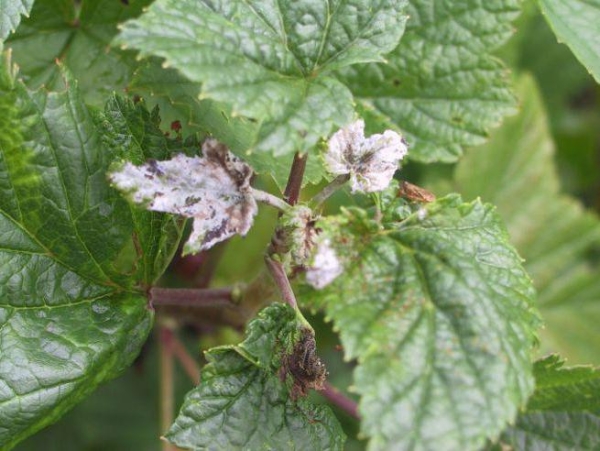
Terry
Dangerous viral disease. The plant thickens, the leaves of the five-lobed become three-lobed, shrink and lose currant smell. At the ends of the branches there are many shoots.
Control measures: removal of black currant bushes and burning. And it is necessary to fight the vector of the disease with a kidney tick.
Anthracnose
The disease affects leaves, petioles, shoots and berries.. Small brown spots appear on them, which then merge into one solid, the leaves curl upward and fall off.
The disease begins in early June and with a strong infection by the middle of summer, the bushes completely drop foliage, the shoots dry out.
Control measures:
- choose disease-resistant varieties of currants, Selechenskaya one of these varieties;
- diseased leaves are removed and burned;
- before blooming buds, process the bushes with a 3% solution of Bordeaux liquids, and before flowering and after harvesting 3%.
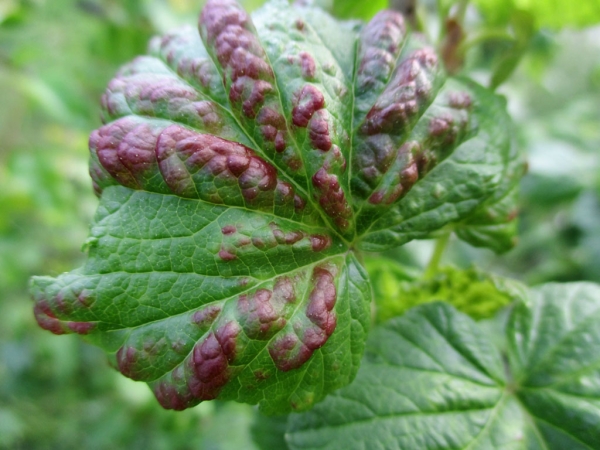
Septoria or white spot
In May, small spots with a brown border appear on currant leaves.which then turn white and blend. The leaves dry out and fall off.
Premature fall of leaves affects the winter hardiness of the plant and the harvest of the next year, as the plant does not develop normally.
Control measures same as with anthracosis.
Black Currant Mite
Small insect that damages the kidneys. The buds swell and round, do not develop and dry out the following year. Insect is a carrier of viral diseases.
Control measures:
- before the beginning of the growing season, patients with plump buds pluck out;
- with a strong defeat of the bush, the branches are removed to the base;
- spend during the season of processing plants infusions of onion, garlic, pine needles;
- spraying before bud break 3% solution of nitrafen or 1% solution of colloidal sulfur.
Black Currant Leaf
A small mosquito damaging the leaves. The leaves first wither, then dry and fall off, the ends of the shoots die off. As a result, fat shoots from the sinuses of fallen leaves appear, the plant is depleted.
Control measures:
- it is very effective to dig the soil under the bushes with its subsequent mulching;
- treatment of bushes before flowering and after 0.2-0.3% carbophos emulsion.

Currant glass bowl
Pest damaging shoots. Caterpillars that hatch from larvae penetrate into the stalks and eat out the middle of the shoot, making passages in it with blackened walls. Damaged shoots wither and dry.
Control measures:
- annual cutting of old and damaged shoots, which are characterized by weak growth and small buds;
- after flowering treatment of bushes with 10% karbofos at the rate of 75g per 10 liters of water;
- from folk methods - processing with decoctions and infusions of pepper, garlic, mustard solution and laundry soap, 200 g each of soap and mustard per 10 liters of water.
Vitamin composition
Black currant occupies a special place among fruit crops. It is not for nothing called a storehouse of vitamins.:
- It contains a large amount of vitamin C up to 340 ml, 15-20 berries per day provide the daily need of the body for this vitamin.
- Currant is rich in vitamin P, which strengthens the walls of capillaries.
- According to the content of vitamin E, it is on the 4th place after the sea buckthorn, wild rose and chokeberry.
- According to the content of vitamin A, it has no equal among fruits and berries.
- The list of vitamins is supplemented with the B vitamins found in it (B1, B2, B3, B6, B9), as well as PP and K.
- It contains an increased amount of potassium and iron salts.
- It has a lot of calcium, phosphorus, magnesium.
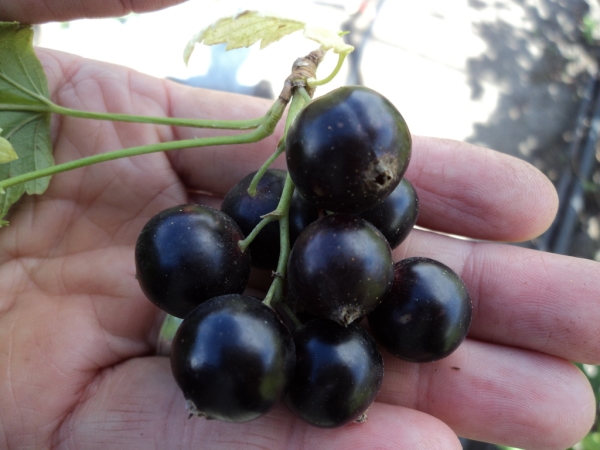
Yes, what is it just not. Organic acids (malic, citric) - is, pectin, tannins and nitrogenous substances too.
In black currant not only berries are useful, but also leaves with shoots. Whoever brewed tea with currant twigs (in the spring in the country) will never forget this taste and aroma.
Grow black currants, and you will never regret the time spent on her care. She will reward you with a generous, tasty and rewarding harvest.
